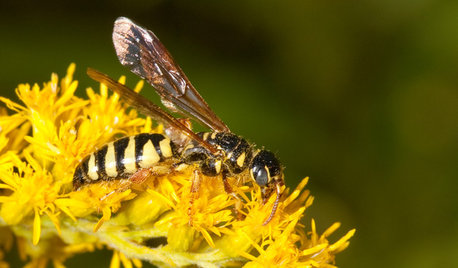How Do You Get Rid of Leaffooted Beetles
Last year I lost almost my whole tomato garden due to Leaffooted Beetles. I found that they were very attracted to Sunflowers, which were planted around my garden. This year, my husband wanted to plant sunflowers and I refused to let him plant them near my garden. He planted them quite a ways away from the garden and I noticed today, his sunflowers are not covered in leaffooted beetles. I was upset when I saw the beetles, but was hoping that the sunflowers would act as a "trap crop" for them. Then I went to my garden and found them covered all over my cucumber plants. I shook the cage that the cucumber plants were in, and they flew away--but that does not mean they won't be back. How can I prevent them from invading my garden, I feel it is only a matter of time before they discover my vegetable garden. I can't find anything on the Internet that says it kills them. They are adults. I have Pyola and Bulls-eye, which are suppose to be for organic gardens, but I don't see anything written that either of those will work on leaffooted beetles. Will appreciate any input on what to do about these devastating insects.
Thanks,
Sheila
Comments (17)
countymounty
18 years agoI also noticed that sunflowers act as a good trap crop for leaf footed bugs. I have the best success when I plant them in between my tomatos, peppers, egplants etc. I find that the leaf footed bugs ignore the vegitables and spend all their time on the flower heads of the sunflowers. Another benefit of the sunflowers is that once they get large enough they provide a lot of shade late in the season which helps prevent sunburned vegitables on the different plants below them.
I have not tried any chemical means of destroying or repelling leaf footed bugs, but the "hand of death" approach works very well. Basically I put on a pair of work gloves and go out and squash as many of the LFBs as I can. It is very easy due to their tendency to congregate on the faces of the sunflower flowers. As you can imagine the HOD approach isn't to good for the sunflower, but since I am mainly growing them for fun, I do not regret the resulting loss of seeds. This year I was lucky enough to catch several LFB "hatches" early in the spring/summer and must have got most of them because so far I have not seen very many adults. I don't need the HOD approach when they are small - but I still get the "fingernails on the chalkboard" feeling when I am handpicking them -ugh!. I have also seen assassin bugs and several small lizards in the garden this year, so maybe mother nature is lending a hand as well.
Related Professionals
Windham Landscape Architects & Landscape Designers · Forest Acres Landscape Architects & Landscape Designers · Sand Springs Landscape Architects & Landscape Designers · Simi Valley Landscape Architects & Landscape Designers · Roxbury Crossing Landscape Architects & Landscape Designers · White Oak Landscape Architects & Landscape Designers · Fort Payne Landscape Contractors · Framingham Landscape Contractors · Kaysville Landscape Contractors · Lady Lake Landscape Contractors · Middle River Landscape Contractors · Vallejo Landscape Contractors · Casselberry Landscape Contractors · Raytown Landscape Contractors · Stafford Swimming Pool Builderscountymounty
18 years agoSheila - do not get discouraged. If it is not to late you could try to cover your plants or wrap the hanging ones with the material used for floating row covers. That would keep the leaf footed bugs off them. I have used row covers to keep squash vine borers off my squash plants. The garden doesn't look as nice with a large section of white row cover in it, it is a pain to hand polinate and to have to raise and lower the cover each time I want to do something in the bed; but it has solved the problem at least for that particular bug. Production may suffer some from the reduction of sunlight but if GA is anything like TX your plants may appreciate a little shade this time of year. Just be on the lookout for young LFBs that may hatch from eggs already laid. They can't fly and are colored orange or bright red in the early stages of life and are much less disgusting to hand pick than the adults (see the link). You might also try dusting the sunflowers and any other place where they congregate with diatamaceous earth - DE. When they return and get it on them it would dessicate them. I know that this works on other bugs, but have never tried it on LFBs. The DE needs to be re-applied after it rains or after it gets damp (probalby every morning if the dew is heavy).
I understand your frustration very well as I was in the same spot last year - even had them flying at my face, talk about a shock the first time that happened! My wife was laughing so hard at my attempts at defense that I thought she was going to hurt herself (laughing from inside the house of course where she was protected from the attack). She said that I looked like the 2 guys in that insurance commercial on TV who are trying to knock the wasp nest out of a tree into the garbage can. So, I also understand the strong desire to go nuclear on them. I have only had the time and space to garden for about 2 years now so I am still learning and I am no where near as knowledgeable as others on these forums. But based mostly on what I have read, I have started trying to incorporate organic practices as much as possible. I am not 100% organic and probably never will be, but I do believe that I have seen an improvement this year over last by reducing the use of pesticides. It seems like every day when I am in the garden I see beneficial insects that just were not there last year, and it seems like there are fewer pests and less related damage as well. You obviously put a lot of time and effort into your gardening - don't give it up just because of a stupid bug (and 10,000 of his friends).
Here is a link that might be useful: Texas A&M website
Sheila_GeorgiaPeach
Original Author18 years agocountymounty: This is my 4th year of gardening, and I am still learning. Every year there is a different type of problem that I have to learn from. In the 4 years that I have been gardening, the only 2 products that I have used that are non-organic, are DE and Daconil & a lot of organic gardeners will use those. Today I went to Wal-Mart and bought a bottle of Bug Stop by Spectracide that is for indoor and outdoor use. Says it kills on contact and kills bees, wasps, scorpions and Asian Beetles. My plan is to be outside at dawn when they are all congricated on the sunflowers and not moving around, and start squirting them there. It is as if they are sleeping during the early hours of the morning. I never see them in my garden during the early hours, only when the sun gets hotter. And yes, it does get very hot here in Georgia--we had temps over 100 for a week last week. Heat index was 105-110. I think it is too late for row covers as my garden is now almost dead from the beetles. And I don't think row covers would fit very well with the bamboo stakes I use for my tomato plants, they are over 6 feet tall and I use about 3-4 per plant. I don't think that DE would work on these beetles because I tired Bulls-Eye (which is for organic gardens) and it works like DE except it is suppose to be stronger acting on pests and is even less harmful to beneificials. It didn't even slow them down. Next year I won't have them for a problem because I am not planning on having a garden next year. I plan to do nothing but work on my soil for a year. In the fall I am going to plant a winter cover crop, and then in the spring I will plant a summer cover crop. I figure if for a year if I do nothing but plant different types of cover crops, and add compost to my soil, then summer after next I should be able to have a good descent garden. Maybe by then the leaffooted beetles will have moved on and I won't have them for a while. I never had them until last year. And thanks for the link because I did not know what their nymphs looked like until then. I will be on the look out for those too.
Thanks,
Sheila
PS I will let you know how it works out with trying to eleminate those beetles in the morning.timtex
13 years agoThe fact that they like sunflowers is interesting, because I grew them for the first time this year and noticed the beetles liked them--it seemed like dirt daubers did, too. The reason I'm at this forum is because I had two outbreaks of the little red/orange nymphs. I had no idea what they were until I did research, and I was just amazed at how much damage a swarm of nymphs can do. They attacked a flower seedling and killed it before I knew what was happening, and then they attacked a Japanese Yew, which is still trying to recover. I don't grow plants for food, so I used Ortho Max spray for vegetables, shrubs and flowers (even though it's apparently okay for vegetables). I understand the outcry against chemicals, but sometimes it's the best solution for a part-time, novice gardner like me.
Sheila_GeorgiaPeach
Original Author13 years agotimtex: It has been 5 years since I posted this problem and I want to tell you that I never did find the solution to my problem with LFBs. For the next 2 years after posting this thread, I kept loosing my vegetable garden to them. That was bad enough, then the fire ants took over too. And there really is not solution to fire ants because they have no natural enemies and nothing you can buy chemically gets rid of them. I live on 25 acres of land and there is no way you can financially afford to treat that much land even if you found something to kill them. I finally quit gardening 3 years ago because of the LFBs and the fire ants. What few vegetable plants that the LFFs did not kill, the fire ants killed the rest. The plants would not grow or produce and when I pulled them up, there were hundreds of fire ants beneath the plant, eating the roots. They tunnel under the garden to get to the plants. They don't eat what local ants eat--they eat woody things such as plants and even your clothes if they get into your house. They almost destroyed all my clothes in my closet one summer. This year they are even worse. Every day I find a new place in the house that they are invading--we can't keep them out. So now I don't garden any more but I try to help others with advice who are planting gardens for the first time. I hope you get your LFBs under control. Hope you don't have fire ants where you live.
Thanks for your input,
Sheilarhizo_1 (North AL) zone 7
13 years agoSheila, what have you used to control the fire ants and the leaf-footed bugs?
I'd like to hear about the ants, in particular. They are absolutely not impossible to get under control.
Sheila_GeorgiaPeach
Original Author13 years agorhizo: We are talking about 5 years ago when I was desperately trying to get rid of them. From what I remember I used numerous different products, more organic products than anything, but also chemicals that were not organic. I remember I even used a a spray that is suppose to be powerful enough to kill hornets (don't remember the name now). But nothing worked-killed on contact but they still kept coming day after day. I tried to only use the chemicals on the sunflowers rather than my vegetables because I was afraid I would poison us if I did. I had over $400 worth of Garden Alive organic products that I tried, Bulls-Eye I remember, and other insect killing products that I had gotten from Garden Alive--just can't remember all their names now-would recognize the names if I saw them. I also tried DE I remember. Sorry I can't remember everything--it was so long ago.
As far as ants go, we can control local ants very well, it is the fire ants that keep giving us fits. My husband has spent lots of money on products that say it is for fire ants, but nothing seems to work. I have read up on everything I could about fire ants, things like you should put the poison granular on the mounds in the early AM because this is when the queen comes to the top--because it is cooler then--that she will go deep in the mound when it gets hot. My husband even pours boiling water on the mounds, but all that does is just make the fire ants that is left make another mound somewhere else. All the surrounding farms around here have fire ants, so even if you could get rid of the ones you have, you are just going to get your neighbors too. Everyone in the neighborhood has to get rid of their fire ants or they just keep migrating to each others farms. We even do things like run over the mounds with our cars every time we see one when we come home or leave the house, and my husband runs over them with the tractor whenever he cuts the grass. They even got into my gardening shed and ate a hole through the large sack of my potting soil and then proceeded to make a mound out of the potting soil! If you know of something that works, please let me know because we are about to have to sell our land just to get away from the fire ants!
Thanks,
SheilaKimmsr
13 years agoThe best source of information about Fire Ant Control is Texas A & M where most of the research into the subject is being done. Most every web site, with good information, I have found copies these people.
The queen in an ant hill does not come up close to the surface, ever. She is too big to move around much and simply stays put and is serviced by workers in the nest.
Pouring boiling water on the mound does little since the soil absorbs the heat fairly rapidly and it does not reach down to where the nest is.
There are a lot of myths and folk lore out there that does nothing to control these buggers and simply wastes you time, energy, and money pursuing.Here is a link that might be useful: Fire Ant Control
Sheila_GeorgiaPeach
Original Author13 years agokimmsr: I can't thank you enough for the link you posted-it is the most informative and best site I have ever read about fire ants. One of the best articles on this site clears up a mystery about our outside cats. For years we have been loosing litters of kittens. Our vet thought it was probably due to feline leukemia--but the babies were so small that blood samples could not be taken. The first symptom to be noticed in these poor baby kittens were their eyes. This part of the article describes what the kittens looked like, especially their poor eyes:
Fire ant wounds are often found on the legs, inguinal region, ventral abdomen, perineal
region (anus, vulva), the muzzle, and the eyes. The glabrous or poorly haired areas of the
body normally have the most sting sites. Lesions around the anus, vulva, lips, nares, and eyes
can be very serious and obviously cause great discomfort. Fire ants may be attracted to these
orifices while searching for moisture. Multiple bites in these areas can be inflamed and
necrotized dramatically.
The eye is the most critical site for fire ant damage. The eyelids may slough along their
margins when enough sting sites are present. Fire ants can also sting the corneal surface.
This causes 1 to 2 mm areas of cloudy edema that can be seen with direct illumination.
Multiple stings on the cornea can create a coalescing ulcer. This may progress from a large,
melting ulcer to protrusion of the Descemet's membrane and rupture of the anterior chamberI printed out the article about Fire Ants stinging animals and plan to take the article to my Vet this coming week. I know he will be glad to have all this information because where I live (rural country) everyone here has a problem with fire ants.
I would have gotten back here sooner to reply to your post, but I can't quit reading the site that you sent me to. I can't thank you enough for the site. Hopefully it will help us to find a solution to control 25 acres of fire ants!
Thanks a million,
Sheilaloren_
10 years agoGood to know the leaf footed bugs like sun flowers. I've also had decent success sucking them up with a wet dry vac with a couple inches of water and squirt Dr. Bonners in the base. The problem is that they hide in the dense tangled foliage of my tomatoes - they don't seem too interested in the larger better pruned tomatoes. I feel like I'd have a fighting chance if I can catch them in an open area when they're still sluggish.
We've also got a dreadful fire ant problem here in Austin, The best course of action seems to be baiting during a dry spell in the fall and then applying orange oil and molasses to the surviving nests around three weeks later. For organic controls in smaller areas I've heard many experienced gardeners recommend beneficial nematodes.
I confess to going postal on some ants in my rose garden and can verify that amdro quick kill is highly effective at permanently destroy invasive red fire ant nests when used according to the instructions.
hollyfred
10 years agoFire ants...here's what we do...we apply horticultural molasses in a 10 ft wide zone around our house. The ants will not be killed. They do not like the molasses though and will move their nest. Give it a day or two to allow them to leave to an untreated area. If they discover that there is nowhere to run...they will tough it out where they are so this is important. On day 3 treat another ten ft out from your home...pushing them further away. Day 4...do the same thing. Continue until you have treated all you want to rid the fire ants from. They will not return for a long time. We generally do this once or twice a year and that is all we have needed to do. Occassionally they will try to move into my compost heap and I disturb the pile with a shovel and wet it thoroughly. I repeat this a few times per day for a couple days and they give up. The pile is too wet and too unstable. I find as long as I keep my pile wet enough, they won't move in at all.
The LFB'S are another story. I am constantly battling them. Hope this helps with fire ants though. We are in the DFW area where fire ants are a huge problem and the molasses works great.
There is a great documentary about fire ants on Netflix that describes what officials are doing to stem the problem. They only have one natural enemy and it is being bred an released to try to get the fire ants under control. This tiny wasps only targets fire ants...nothing else....so when the fire ants are someday eradicated, the wasp will naturally follow suit.
Kimmsr
10 years agoMost every bait recipe I have seen for controlling ants, fire, black, red, uses molasses as the attractant. Ants often seek something sweet and molasses fills that desire.
I have seen nothing to indicate that molasses actually does anything except bring ants in to the poison that is hidden in the molasses.zzackey
10 years agoLook for the leaf footed bug eggs in the spring under the leaves and squash them They are hard to catch. They must have great eyesight. I try to sneak up on them and dab them with my sticky tape wand. I got one the other day. Missed one too. Got Grandpa stink bug with it. What a joy! Darn thing is biting my nice Roma tomatoes and ruining them. Still have to catch Grandma stink bug. I never knew they got that big!
zzackey
10 years agoI just had an IPM class. Only certain sunflowers attract them. Gigantia and Mamouth are the ones I can think of. Then there is an organic spray to kill them. Sorry I forgot the name of it. They cram so much info in a few hours of class.
lesa002
7 years agoI noticed them on a container cherry tomatoe plant. First I sprayed with 100% Neem Oil, waited a day and sprayed Bt. I also have sunflowers and they are on them. I hesitate to spray anything on the sunflowers because bees and finches love them. Have not noticed many on the tomatoe plant since spraying. But living in West Georgia with our 90+ degree weather spraying Neem Oil could very well burn leaves. There's a utube video by a lady who uses Neem Oil for the nymphs.

















Sheila_GeorgiaPeachOriginal Author